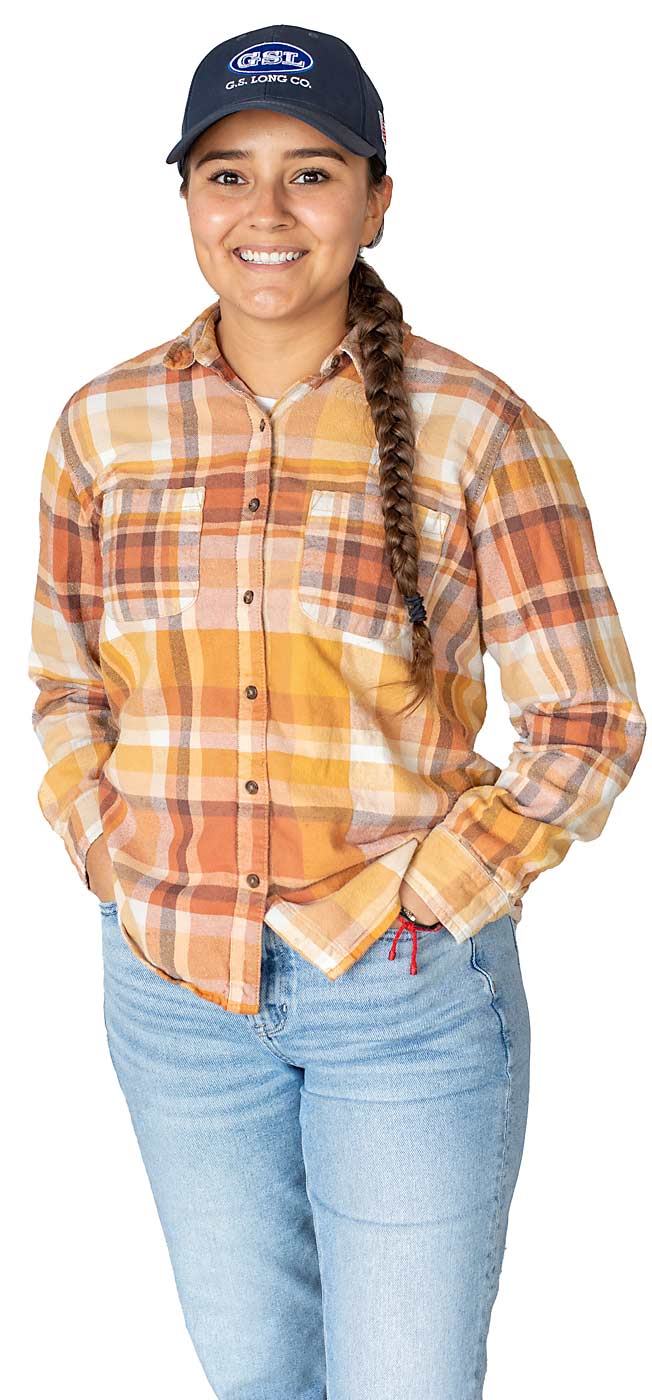family background/ Jutsely is a second-generation farmer who earned an environmental studies and chemistry degree from Gonzaga University. She’s the daughter of Ana Valenzuela and Jose Rivera.
age/24
grower/Moxee, Washington
crops/apples, cherries and grapes
business/G.S. Long

How did you get your start?
I started helping in agriculture about 12 years ago when my family moved to the Yakima Valley. I mostly helped with the apple and cherry maintenance around the farm, thinning apples and painting the tree trunks of younger trees.
After high school, I took an unconventional route into this industry: I worked toward a biochemistry degree with the intention of going into the medical industry. As time progressed, I realized working in that industry wasn’t my thing.
I always had a love for agriculture, so I switched my degrees around and went into environmental studies and chemistry and decided to approach the industry from that perspective.
How did you end up in the role you have now?
Growing up helping my parents, I had a pretty narrow view of working in agriculture. Through those experiences, I knew of G.S. Long and that they worked with chemicals, so I decided to approach that side of the industry and see what having a career with them might entail, and what kinds of things there would be for me to do. Learning more about their company helped me get a research and development internship with them during my second year of college.
I was already in love with agriculture, so I set my foundation in that direction and dove into it from there. I kind of do several jobs here at G.S. Long. I do a lot of scouting and research and development during the summer and, during the winters, I help with grower services, trying out new tech that the industry is barely getting into and then help with implementing new technologies.
When I started working in R&D, I found it fascinating that I could finally do the application aspect of the chemistry degree I obtained — just being able to set up a trial, what to look for, what data to collect, doing evaluations. Those were always cool to me and fun to pursue.
How do you approach field research?
There’s definitely a lot of technology that field representatives can apply, and one of the biggest shifts is toward precision agricultural techniques. We are able to collect data that’s representative of what’s going on in the field.
With that information, we can then make precise decisions for managing pests, diseases and nutrients. Having the R&D team be part of that program gives us the ability to use new sprayers, kinds of applications and other new technology in general.
Being more precise and accurate with your program helps the grower, too. If a field rep can better apply our nutrients and manage our pests and disease controls, then we can lower our impact and costs.
Can you share some examples?
There are ways to improve how we farm on our ranches, and one of them is consistent pest trapping. Being able to monitor, for example, codling moth in apples. A challenge of trapping is that it’s very labor intensive, because it takes so much time and so many people to get it done.
The work ultimately helps the field consultant and the farmer when making management decisions. We also do a lot of soil, leaf and petiole analysis so we can apply only what nutrients the plant and crop need, instead of under- or overapplying.
What lessons from college have helped you the most?
Learning the scientific method in college has helped me a lot, because it helped me, especially in R&D and in trials, approach problems in a manner that would be the most effective. These results are what I show to customers and field consultants.
Last year, when my co-worker and I tested a new product, we designed the trials so the information we gathered would be helpful for the grower. At the end of the day, we’re using their land to conduct these research trials, and it needs to be mutually beneficial.
An important aspect of developing that field trial project was finding a block that has the same size, is evenly loaded and spaced.
It’s important to have equal or similar data points to analyze from the blocks, or you get really skewed results. What I learned in college set a foundation so I can create good plans and evaluate the results to the best of my abilities.
What would you tell other young growers?
As a college student trying to get into the industry, there’s a lot to do, a lot of new tech and methods to monitor ranches in the industry. It’s not just labor-intensive work that’s needed.
There’s a lot of problem solving, pest and disease work, and there’s a diversity of paths you can take. I learned that I was able to take nonagricultural classes to find work in ag, and I realized that no matter what degree you’re doing, it can be applied to agriculture.
There’s different routes, and you may not realize all the different jobs that are in the industry. It’s good to bring in new methods and ideas.
—TJ Mullinax






I can honestly say Justely called me 2017 asking if I knew of any chemical business that she could do her internship my first thought was one and only Jeff Stor of GSL Gary Long and the rest is history. I’m proud I hired her parents at Black rock ranch in 2009 when they landed here from CA and the following year I put her dad in charge of pruning crews and he has worked his way up to Assit Mgr I’m very proud of this family